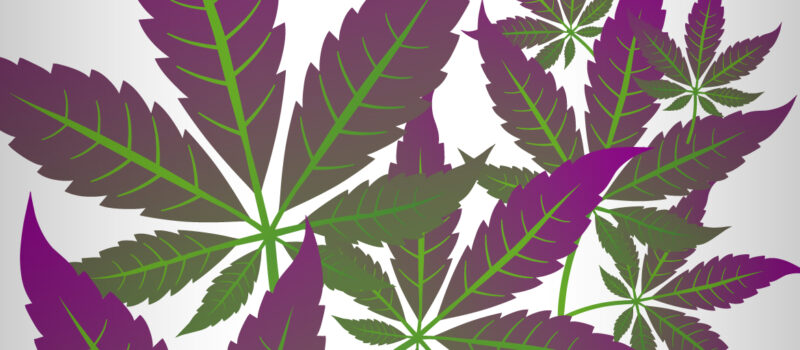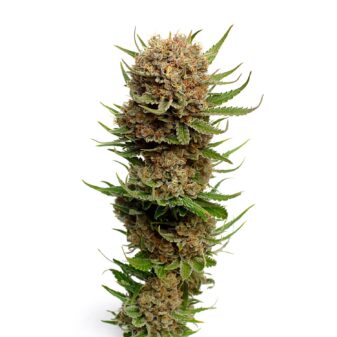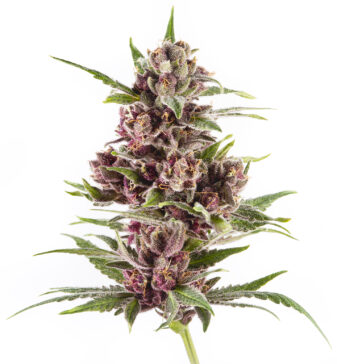These days, growers and connoisseurs look for much more than just THC when picking their favourite weed. The dazzling flavours and sophisticated effects of terpenes are an important new focus. Recently, though, growing plants with amazing new colours is becoming all the rage. This blog explores purple cannabis, explaining how buds can change colour as well as providing growers with tips for raising their own purple, blue, or even pink plants!
Table of Contents
How Green Cannabis Turns Purple
In order to understand how some cannabis develops purple, blue, or pink flowers and sometimes leaves instead of the usual green, we need to understand some basic physics of colour and light.
We can see the myriad dazzling colours of the plant kingdom because light reflects off the various pigments that plants contain. In essence, we see a given colour when our eyes detect light of a certain wavelength, or frequency. Sunlight contains all colours and wavelengths of the spectrum, yet our eyes are able to take in part of that spectrum.
When light hits a surface that ‘has’ a certain colour, say, green, the green part of the spectrum is reflected off the surface. The other colours of the spectrum are absorbed. A green cannabis leaf, then, absorbs all colours except green, and then reflects that green light onto the retina of our eye.
If a cannabis plant somehow managed to reflect another part of the spectrum, we would see a different colour. That is what happens with purple, blue, and pink cannabis plants. As it turns out, these unique strains have different compounds in their cells due to external factors like temperature as well as their genetics.
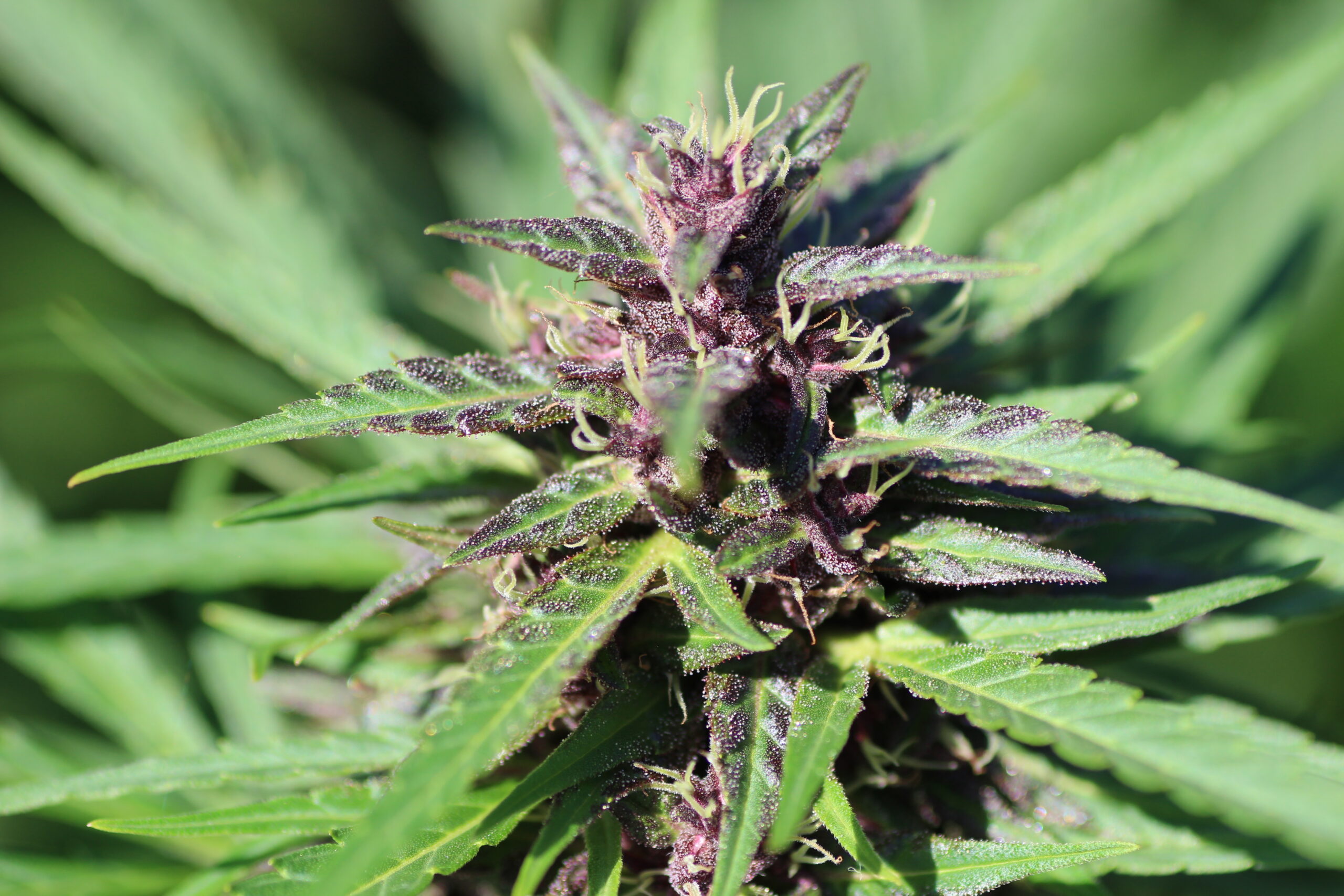
Purple Cannabis Phenotypes
Most cannabis strains with deviant colours only have the potential to turn purple or blue – they don’t do so by default. Usually, their grow environment has to meet certain criteria to change their appearance. This is because of genetics. A given strain may carry a propensity for blue, pink, or purple shades in its genetic codes but never show its ‘true colours’. In geneticist’s terms, we say that purpleness is in the strain’s genotype, but its individual phenotype does not show it. Phenotype (or ‘pheno’) denotes how an individual plant expresses all the various genetic possibilities it carries in its DNA.
This explains how a cannabis grower could raise five plants of the same strain, with only one or turning pink and two others turning purple while the rest stays mostly green. Working with nature is always a bit of a gamble – but that’s all part of the natural charm!
The Taste Of Green
Most plants, including weed plants, are green. The pigment that makes cannabis green is pretty well known: chlorophyll. Apart from the visual aspect, this pigment is recognizable by a bitter, taste – found in cheaper CBD Oils for example. Chlorophyll also conveys an acrid, unpleasant taste to cannabis if smoked; this is why growers trim excess leaf material and ‘sugar leaves’ from their harvest before consumption.
This green plant colourant is the same substance that gives lettuce and other vegetables their green colour. Anyone with a varied vegetable diet eats plenty of chlorophyll every month, although our human metabolism can’t do much with this substance.
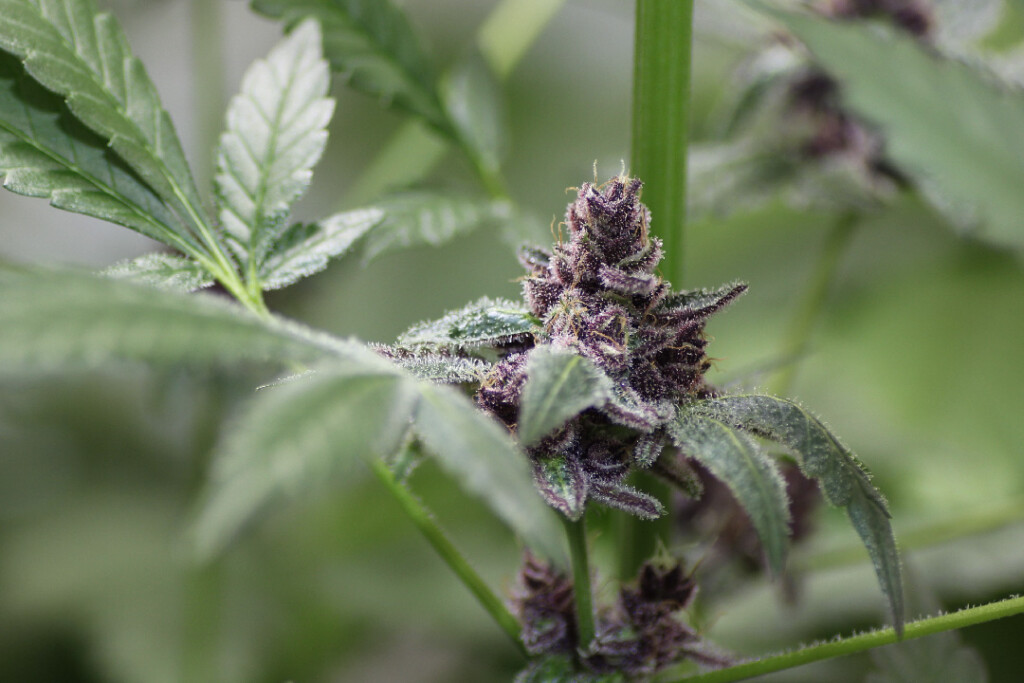
Why Purple Cannabis Is Still Green
For plants, though, chlorophyll is absolutely vital. Photosynthesis would be impossible without the green chlorophyll in the leaves of (cannabis) plants. In photosynthesis, sunlight is converted into energy ready for use in plant growth, development, and flowering. The green leaves of our weed plants are like the solar panels of the species, and so, if cannabis weren’t green, it could never grow in the first place.
Okay, so weed plants need to be green in order to get energy and grow. Well, you may wonder, then why are some cannabis strains purple, or pink for that matter? Interestingly, purple cannabis derives its colour from another plant compound than chlorophyll. The substance that makes weed plants turn purple is called anthocyanin. Anthocyanins or anthocyans form a group of around 400 water-soluble pigments, belonging to the ‘flavonoids‘ category of plant compounds. After cannabinoids (like THC and CBD) and terpenes, flavonoids are one of the most important components that make cannabis such a versatile, unique, and much-loved plant species.
Don’t think, however, that purple cannabis strains have somehow ditched their obligatory chlorophyll content. All strains need their photosynthetic energy, so even purple weed is still green at heart.
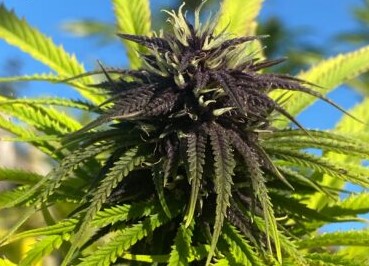
Purple Cannabis & More
Anthocyans do not always manifest themselves in purple hues, though. Depending on the acidity of the plant’s grow environment, this pigment can show different colours. In acidic environments these anthocyans turn red or pinkish. More neutral pH levels make anthocyans appear purple, whereas alkaline environments turn this cannabis pigment blue.
Pink Cannabis Strains
Cannabis with pink rather than purple shades can present growers with spectacular sights. Even so, pink and red cannabis strains are much harder to find than purple ones. In their ongoing quest for genetic excellence, however, our breeders have developed Candyfloss, a deliciously sweet sativa hybrid that can turn bright pink with hints of purple if treated just right. This is quite a rarity in the world of weed; however, with popular demand for exotic colours on the rise, don’t be surprised if we come up with new innovations to expand the cannabis palette…
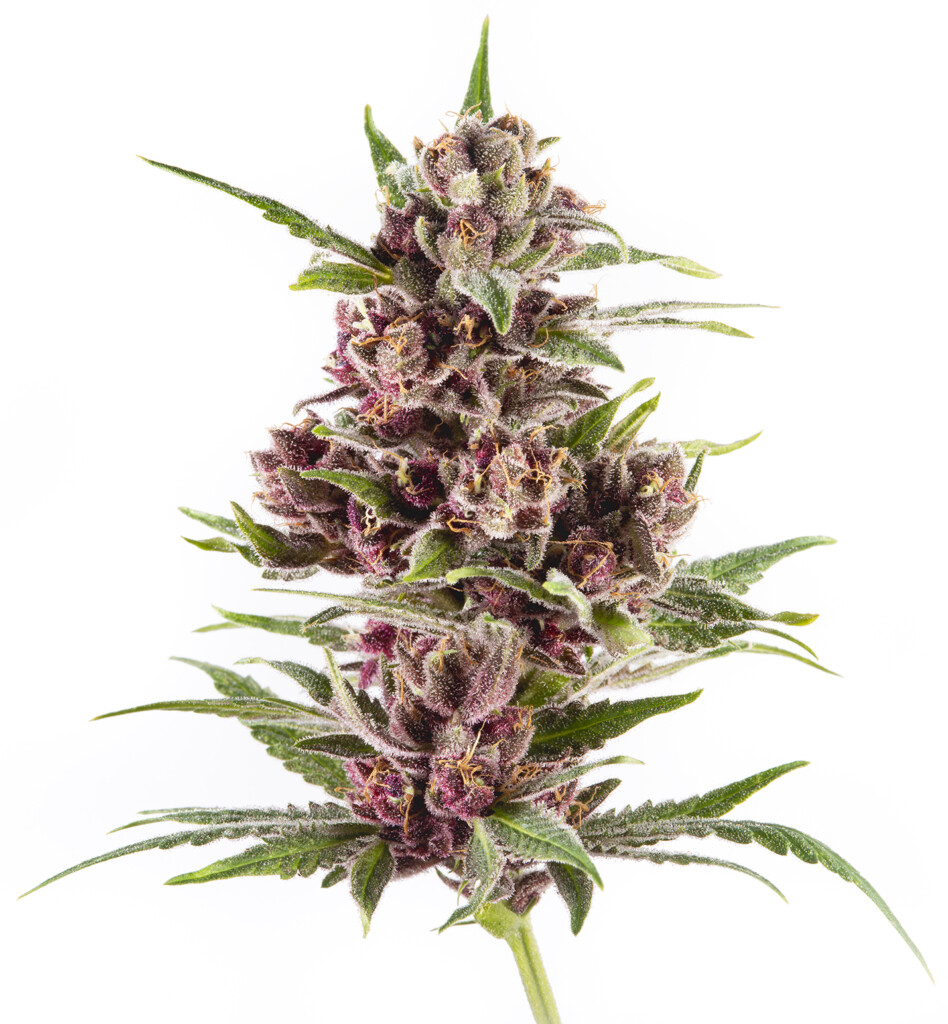
The word ‘anthocyanin’ comes from Greece. German botanist Ludwig Marquart first discovered the pigment in 1835. He named it after anthos (flower) and kyanos (blue). However, this doesn’t mean the purple in cannabis only shows on the flowers of the plant. Even the leaves, stems and branches can show the beautiful colours of anthocyanine. But what exactly triggers a cannabis plant to turn pink, blue, or purple?
Cold Nights & Genetics
The most important element in growing purple cannabis is genetics. Some cannabis strains simply produce more anthocyanins than others, though these colours are not always visible throughout the plant’s lifecycle. Nor does a strain’s name carry any guarantee, as any experienced grower will confirm.
In outdoor grows, anthocyanins become more prominent when cold nights make chlorophyll break down into sugars used for cannabinoid production. It is thought that cannabis turns purple as a survival mechanism. When temperatures drop, a darker hue may allow the plant to trap more warmth in its tissues. Purple cannabis could also attract other insects than green variants, possibly to accommodate for changing needs related to cool weather.
Chlorophyll is a dominant pigment. Its green hue often obscures any hints of purple or blue. However, as soon as the days and nights turn colder, the cannabis plant starts turning chlorophyll into sugars. These sugars power the production of flowers, cannabinoids and seeds. Once enough chlorophyll is broken down, any purple, blue, or pink shades will start to shine through.
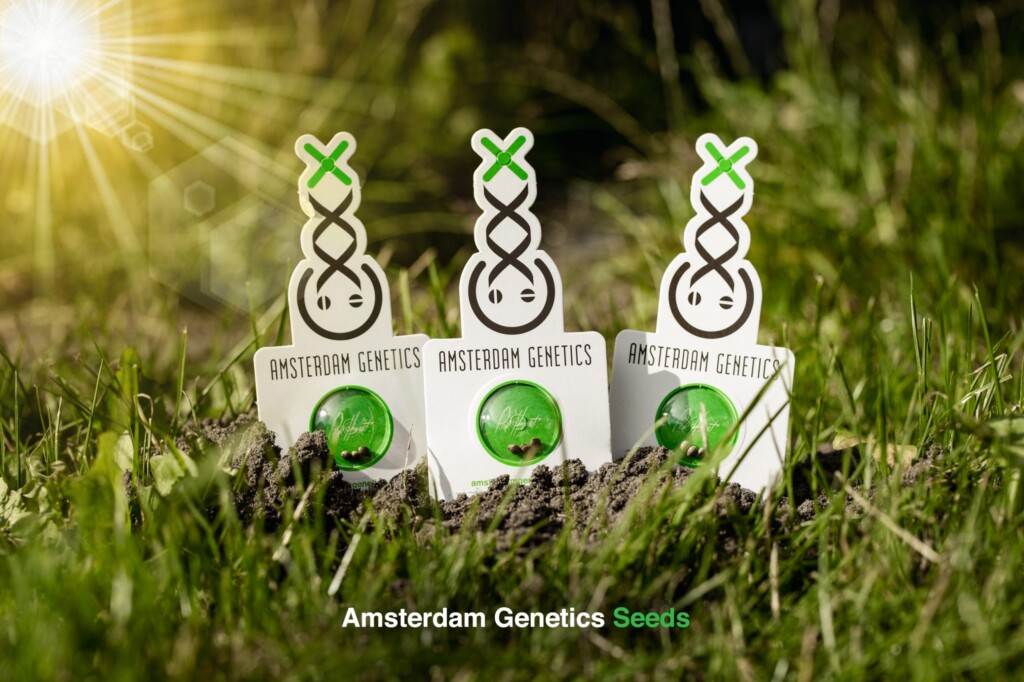
Purple Genetics From Amsterdam
As we have seen, finding purple cannabis strains is a matter of matching the right genetics with the right circumstances. At Amsterdam Genetics, we develop award-winning strains to suit any grower’s desires. That means we usually aim for great cerebral and body highs based on genetic stability and descent, balanced terpene profiles, and novel hybrid crossbreeds. So yes, most of our weed is green. Still we do have several premium cannabis strains with distinctly colourful phenotypes, including purple and pink flowers. With a touch of luck and the right grow conditions, any cannabis grower can use our strains their green thumbs to grow purple flowers!
Discover The Colours Of The Amsterdam Genetics Range
As mentioned, our deliciously sugar-sweet Candyfloss strain tends to develop distinctly pink phenos. Even if she stays green, though, her lovely flavour and profound sativa high are more than enough to make that grow worth a try.
As their names suggest, our Blue Amnesia Haze and Blue Amnesia Autoflower strains have a tendency to show some blue in their buds too. This can result in a cannabis harvest with a purple sheen, again depending on grow environment. Double Blue is known to carry purple in its genetics too, and our Blue Monkey CBD cannabis may combine its unusual cannabinoid profile with surprising colours as well!
Adding Colour To Those Flowers
Growing cannabis specifically for purple flowers, or any other deviant colour, can be a bit of a challenge without guaranteed success. Still, just to show you how amazingly beautiful the results can be, we close off with this stunning picture of an Amsterdam Genetics Pineapple Kush grow.
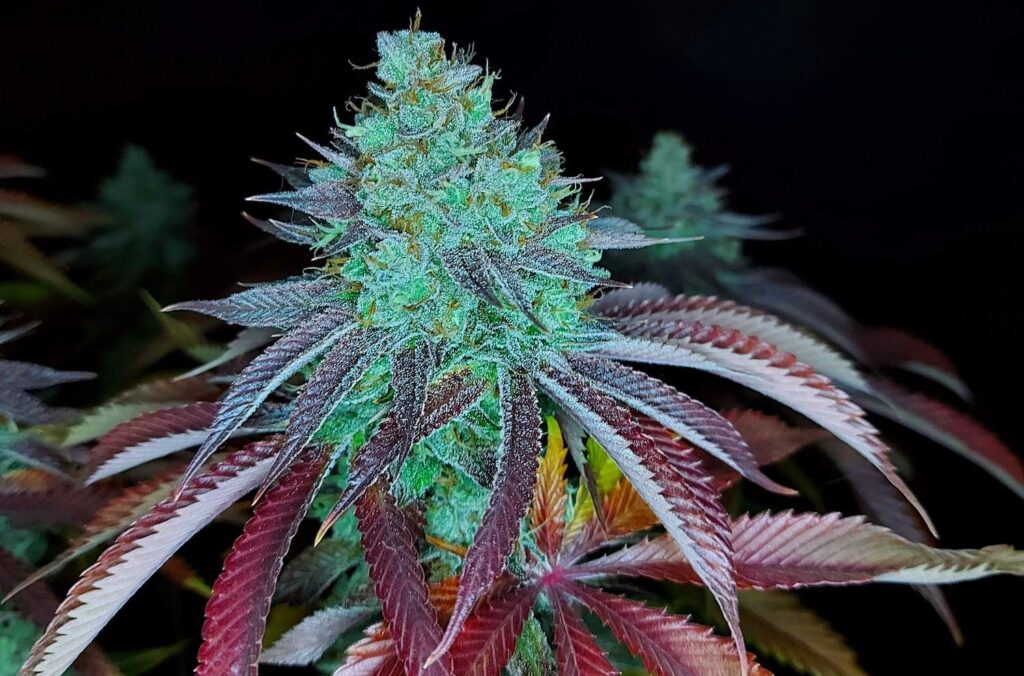
The point is that even though this strain is famous for its amazing taste rather than any exotic colours, getting those grow perimeters just can make a purple, pink, or rainbow-coloured plant out of just about any cannabis strain!








